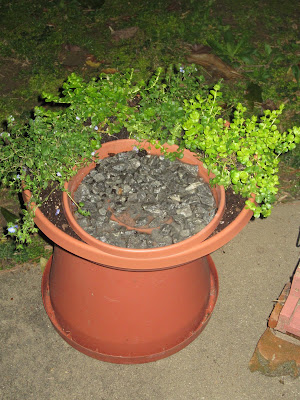What do beekeepers do in the dark of the night? We move bee hives!
A kind woman named Lisa who studied about beekeeping with Don Kuchenmeister in Lula, Georgia and who got these bees from the Georgia bee lab donated this hive to the Metro Atlanta Beekeepers for our hive inspection program. She lives in Lilburn, about a 35 minute drive from Julia's house.
Immediately after work tonight, skipping dinner, I drove to Julia's house, we loaded up the car with what we needed, and drove to Lilburn to get these bees. For those of you who don't know, bees are ideally moved at night because all of the foragers are home for the evening and it's a calmer move than trying in the day time.
The hive is one of those English garden hives with the lovely rooftop. Here's how it looked before we moved it.

I had been worrying about it all day - it was potentially 160 pounds of bees and honey and boxes. Lisa said her driveway was quite steep, and it's easy to make errors when one is tired at the end of the day. It turned out that the biggest challenge of moving this hive was backing down Lisa's steep driveway.
We brought flashlights, a staple gun, screened wire to staple the entry, and our bee gear, just in case. Noah is stapling the entry closed with screened wire in this picture.
Julia strapped the hive together with her hive strap. And then we loaded it into Julia's car. It wasn't very heavy and although it looked like Julia, Noah and I were all carrying it, actually the two of them had all the weight so I let go to take this picture.
Below you can see Lisa and Noah. We are so grateful to Lisa for donating this hive since we have no bees at the Blue Heron and the inspections for our club are about to begin. Lisa also gave us an eight frame hive that we will use for bee inspections at Chastain Park, if we get permission to keep bees there. (Have I told you all about Chastain Park Conservancy and our dreams of having bees there? - if not, I'll post soon.)
Then in the dark of night we drove to the Blue Heron (after a quick stop at Chick Fil-A so I could get something to eat, having skipped dinner). We were a little scared - after all, there has been vandalism at our Blue Heron hives and it was 9:00 PM by this time. Noah told us loud and funny stories as we walked guided by flashlight up into the apiary to make sure our cinder blocks were placed OK.
We set the hive up and then put some vegetation on the landing entry so the bees would orient themselves when they fly tomorrow.
Here are Julia and Noah in the dark beside our newest hive. We faced it east and hope it will live and thrive.
Noah, who will be chief in charge of this particular hive, checked with the level on his phone to see if the hive were level. Satisfied that it was level enough, we went home. I got back to my house at 10:10…..what a long day, but so fulfilling to end it this way.





































